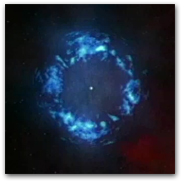An overview of the Chandra mission and goals, Chandra's namesake, top 10 facts.
Classroom activities, printable materials, interactive games & more.
Overview of X-ray Astronomy and X-ray sources: black holes to galaxy clusters.
All Chandra images released to the public listed by date & by category
Current Chandra press releases, status reports, interviews & biographies.
A collection of multimedia, illustrations & animations, a glossary, FAQ & more.
A collection of illustrations, animations and video.
Chandra discoveries in an audio/video format.
Whence Supernovae?
by WKT
May 31, 2006 ::
The remnants of catastrophic explosions called supernovas (or supernovae, if you prefer the Latin plural) are among the favorite targets of scientists who use Chandra. For good reason, too. Supernovae and their remnants have proven to be of profound significance: for understanding the origin of the elements that are necessary for life, as cosmic laboratories for studying extreme physics, and as distant lighthouses that tell us about the accelerating expansion of the universe.
The discovery of supernova remnants also provides a fascinating example of interdisciplinary research between historians and astronomers.
Historical records, primarily from China and Japan, dating back two millennia, contained intriguing mentions of "guest stars" or "new stars," or "stellae novae," or "novae" for short. These objects would appear in a region of the sky where no star had been recorded, and then fade away. Very likely, none of the novae observed by the ancient astronomer/astrologers were actually new stars.
With the development of the telescope, astronomers gradually came to understand that some novae were due to peculiar stars that flared up 10,000 to 100,000 - fold in brightness, then gradually faded over a period of weeks or months to become dim, but detectable stars. Some novae are observed to recur on a time scale of decades. We now know that these novae occur in binary star systems containing a normal star and a white dwarf star, which is the dense remnant of a very old, sun-like star. Material pulled from the companion star falls onto to the surface of the white dwarf and triggers the outburst.
However, not all novae fit into this category. Some seemed to show a different, more extreme pattern of rising and falling, and some were located in peculiar nebula. But it was difficult to know the absolute brightness of these novae, because their distance was not known. Then in the 1920s, Edwin Hubble and others used more powerful telescopes to show that the nebulae that harbored some of the peculiar novae were galaxies in their own right, at distances of millions of light years from Earth.
When
Walter Baade, a Caltech astronomer, made a thorough investigation of the distances of these galaxies and the brightness of the novae, he came to the startling conclusion that at maximum brightness, these novae must have been more luminous than 100 million to a billion suns! These events clearly represented an explosive event of a radically different kind which involved the entire star, not just the outer layers.
Baade and his Caltech colleague Fritz Zwicky wrote a paper about these superluminous novae, and coined the term "supernovae", to describe them. This led to a reexamination of the records of several historical novae in our Galaxy, and a search for their remnants.
A description of the nova of 1054 in the chronicles of the Sun Dynasty led to the identification of the spectacular
Crab Nebula, and a study of Old Arabic, Latin, Japanese and Chinese chronicles led to a similar identification for the remnant of the nova
of 1006. In 1941 Baade used the 100-inch telescope at Mt. Wilson to find the remnant of Kepler's nova of 1604, and in 1952, Rudolph Minkowski of Caltech used the 200-inch telescope on Palomar Mountain to locate the remnant of the Tycho's nova observed in 1572.
In the 1960s, the best way to locate supernova remnants was through the detection of a bright ring of radio waves, which located the rapidly expanding shock wave produced by the explosion. It was predicted that such shock waves could heat gas to millions of degrees, and with the advent of focusing X-ray telescopes this prediction has been borne out.
The Chandra supernova remnant catalog lists over 50 objects, and it is now understood that more than one type of supernova exists. More about these types coming soon...










